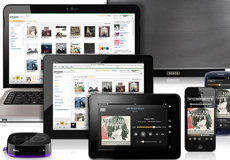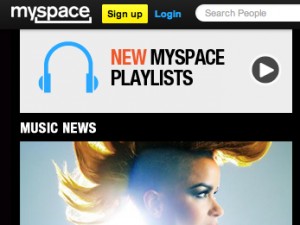By
Rob ScottFebruary 19, 2013
SoShare is a new tool from BitTorrent designed for sending large files from person to person, allowing users to send bundles of up to 1TB for free. The app combines BitTorrent file transfer technology with cloud caching, so users can access files even when the sender is offline. The SoShare software — which targets media creators such as musicians, photographers and filmmakers — keeps files available for up to 30 days. Continue reading BitTorrent Launches SoShare App for Sharing Media Files
By
Rob ScottFebruary 8, 2013
The streaming music service Deezer has announced partnerships with Samsung, Toshiba and LG that could possibly make the Deezer app available to some 600 million people across more than 150 countries. However, the deals are limited in scope since Deezer will initially only be available on Samsung smart TV models produced from 2011 (Europe only) and LG models from 2011 (worldwide). Deezer does not have a deal in place for the U.S. Continue reading Deezer Expands Global Music Streaming with Smart TV Deals
By
ETCentricJanuary 22, 2013
Analytics provider Next Big Sound has released its State of Online Music report, which provides a detailed look at how social networks, streaming services, online radio and digital downloads are impacting the way consumers discover and share new music. Online growth was staggering in 2012 with a 45 percent increase in new plays, 67 percent increase in new fans and 6 percent increase in new profile views. Continue reading Next Big Sound Tracks Online Music Discovery and Sharing
By
Rob ScottJanuary 22, 2013
Justin Timberlake released his latest song, “Suit & Tie,” on Myspace last week in order to promote both his new album and the revamped version of Myspace (Timberlake is a minority partner in the group that purchased the social network in 2011). The new Myspace, which lets users listen to music for free in order to help promote artists, has drawn early praise for its functionality and sleek design, but it may have hit a bump in the road as a coalition of indie record labels claims the network is using music from member labels without permission. Continue reading Revamped Myspace Hits Snag with Independent Record Labels
By
ETCentricJanuary 21, 2013
Amazon has launched a browser-based MP3 store featuring 22 million songs. The move directly challenges Apple since the store allows consumers to use their Apple devices to access music through Amazon’s Cloud Player app. Much of the music is cheaper than iTunes because Amazon does not have to pay Apple the 30 percent commission for sales through iTunes. This allows Amazon to offer specials like 69 cent songs and $5 albums. Continue reading Amazon Launches HTML5-Based MP3 Store to Compete with Apple
By
ETCentricJanuary 10, 2013
The HP Pocket Playlist is a surprising little drive HP is demonstrating at CES this year. It’s a portable storage device that allows for the streaming of unencrypted content to up to five mobile devices at one time. The company says it can hold up to 16 full-length movies, 7,600 songs, 10,000 photos, or any combination of those (assuming 2GB per movie, 4.3MB per song, 3.2MB per photo). Continue reading CES 2013: HP Unveils $129 Mobile Wireless Storage Expander
By
emeadowsJanuary 4, 2013
Heavy-hitting music-streaming company Deezer wants into the U.S. market in order to increase its overall market share. The Paris-based Spotify competitor launched a free streaming service in late December in more than 150 countries. The service currently allows users two hours of free listening per month on desktops and laptops, marking the first time the company has offered a free service backed by advertising outside its native France. Continue reading Spotify Rival Deezer Launches Wide, Seeks U.S. Partner
By
Rob ScottJanuary 3, 2013
In a five-minute video report on the Wall Street Journal, Walt Mossberg discusses four personal technology topics that he believes may prove to be significant trends in the coming year, including a new era of smart TVs, more affordable smartphones and mobile plans, a new wave of more expensive music players and new health and fitness gadgets and accompanying apps. Additionally we should expect to see more tablets and more use of the cloud. Continue reading Walt Mossberg Looks Ahead to Personal Tech in 2013
By
Rob ScottDecember 17, 2012
Amazon’s cloud-based music storage and streaming service is now available on Roku and Samsung’s Smart TVs, allowing users to play digital music on a single device. The app “finally gives Roku a good response to Apple TV’s iTunes Match,” notes CNET. Months ago Roku announced that the Amazon Cloud Player was “coming soon.”
 Like its competitor iTunes Match, Amazon Cloud Player charges $25 per year to store up to 250,000 songs. It also includes a feature that automatically identifies music files and upgrades the quality using a 256 Kbps file from the Amazon catalog. “That’s a ton of digital music, although the competing Google Play Music allows you to store up to 20,000 tracks for free and is available on Google TV devices,” explains the post.
Like its competitor iTunes Match, Amazon Cloud Player charges $25 per year to store up to 250,000 songs. It also includes a feature that automatically identifies music files and upgrades the quality using a 256 Kbps file from the Amazon catalog. “That’s a ton of digital music, although the competing Google Play Music allows you to store up to 20,000 tracks for free and is available on Google TV devices,” explains the post.
The release was announced the same day that Amazon added its Amazon Instant Video app for the iPhone and iPod touch.
According to a related post from CNET, the Instant Video streaming app “allows for access to over 140,000 movies and television shows that can be downloaded for purchase or rental.”
Amazon offers access to its streaming library across devices including the iPad, Kindle Fire HD, PlayStation 3, PCs and Macs. The app is only available to customers who pay for the company’s $79-a-year Prime membership.






